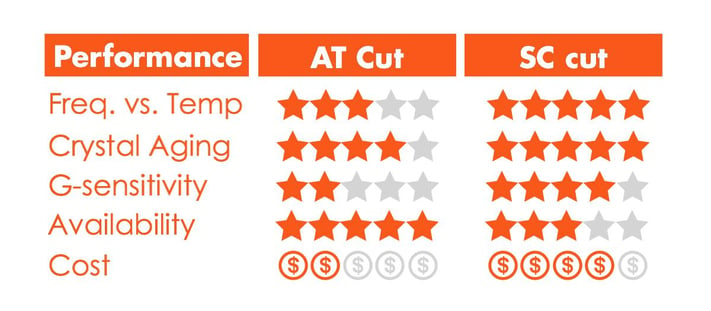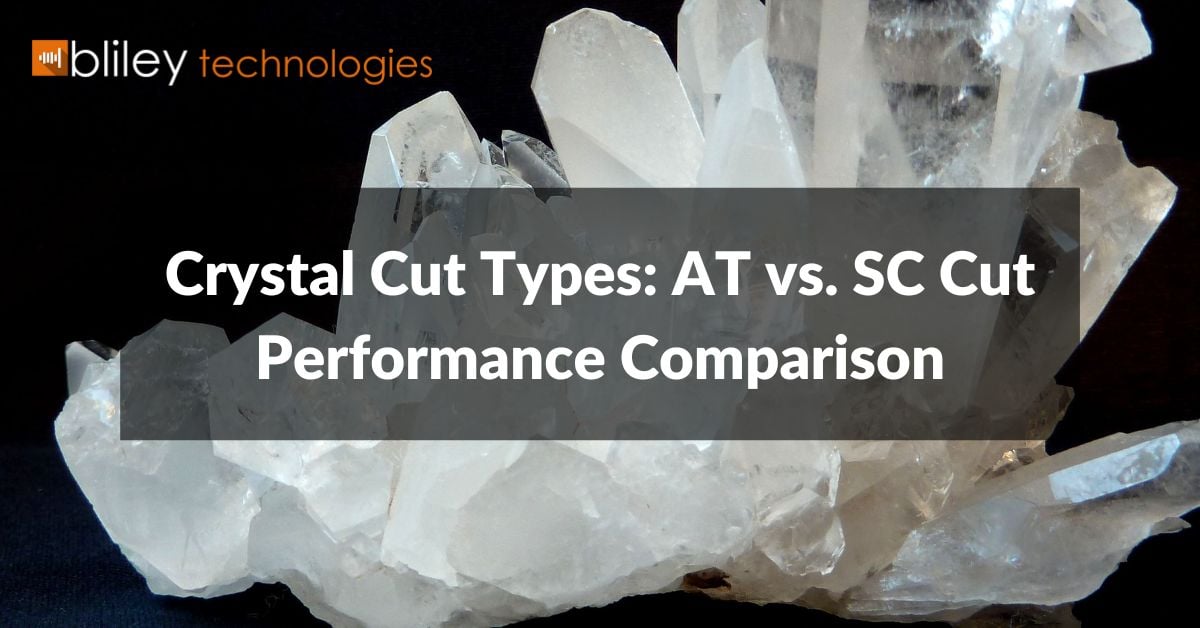Inside every quartz oscillator is something called a crystal blank. The crystal blank is the resonating element of the oscillator that, when subjected to a voltage potential, will begin to vibrate and oscillate at its fundamental frequency.
The way the crystal blank is manufactured can have a significant impact on the oscillator's performance. In this blog, we'll be discussing how the orientation of the quartz when the crystal blank is cut can affect how your oscillator performs.
What Are Crystal Cuts & Which Types Are Used in Oscillators?
Crystal blanks are cut from larger pieces of bulk quartz. Since quartz crystal has a predictable, lattice-shaped internal structure, the orientation or angle of the lattice structure can create different "cuts" of crystal blanks.
AT and SC cuts are two of the most common types used in oven controlled crystal oscillators (OCXOs). And just like with any other engineering or design decision, there are advantages and disadvantages that must be considered during the design phase of frequency control devices.
The AT is a temperature-compensated cut, meaning the cut is oriented such that the temperature coefficients of the lattice will have minimal impact on crystal performance.
The SC is a stress-compensated cut, but it is also temperature compensated. Originally developed in 1974, the SC cut is a double rotated cut (similar to a compound miter cut for the woodworkers out there).
Comparing the Differences Between AT-Cut & SC-Cut Crystals & Their Impact on Oscillator Performance
When selecting an oscillator for a specific application, it's important to understand the type of crystal at the heart of the oscillator. The key parameters that differ between AT cuts and SC cuts are frequency vs. temperature stability, crystal aging, g-sensitivity, initial frequency accuracy, availability, and cost.
Frequency vs. Temperature
Frequency vs. temperature stability (FvT) is a spec that describes how the frequency output of the oscillator changes over temperature. FvT performance is measured in parts per billion (ppb).
SC cut delivers improved performance, mainly because of the slope of the curve in the vicinity of the crystal’s turning point. Typically, the slope of the SC cut is ⅓ that of an AT cut with the same turning point.
SC cut also delivers improved FvT performance when operating at elevated temperature ranges (-20C to +200C), as seen in downhole applications. With an inflection temperature of approximately +90C (compared to +27C for AT cut), the SC will achieve tighter stability over these ranges. The improvement could be as much as 5x over this extended temperature range.
Crystal Aging
Crystal aging is a spec that describes how the frequency of a crystal changes over its life. Crystal aging occurs as a result of impurities within the oscillator and is also measured in ppb.
SC cut is less sensitive to some of effects of aging, such as crystal mount stresses, crystal blank plating stresses, and changes in performance of the electronics.
Related: Oscillator Aging: How Ling Is an OCXO's Shelf Life?
G-sensitivity
G-sensitivity describes the impact of shock and vibration on the frequency output of the oscillator. G-sensitivity is measured in ppb/g. Because the quartz crystal is an electro-mechanical device that vibrates under a voltage potential, introducing a vibration can cause the electrical output characteristics to change. In fact, g-sensitivity is a major contributor to the phase noise of an oscillator.
SC cut has lower g-sensitivity than AT cut. Low g-sensitivity is important for applications that will experience large vibrations and shocks.
Availability & Cost
Because SC-cut crystals tend to have better performance when it comes to FvT, aging, and g-sensitivity, they are more expensive than AT-cut crystals. While AT cut is more commonly available and more budget-friendly, you will need to examine your application's requirements to determine whether it needs the higher performance of an SC cut.
The following table summarizes the comparison between AT-cut and SC-cut crystals when used in OCXOs:

Related: AT vs. SC-Cut Quartz Crystals: Is EFC Over-Specification Costing You?
Selecting the Right Crystal for Your Next Project
Now that you know the differences between the two most common crystal cuts, you can make a more informed decision about which to use in your application. If you have any additional questions, please feel free to send our engineers a message.
Explore our full line of high performance crystal oscillators >>







